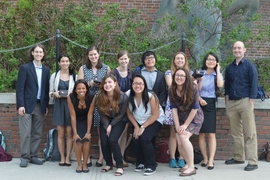How do you take something good and make it even better? Get others to collaborate. Diverse skills, talents, and perspectives can add value and produce even greater impact compared with working alone.
MIT is a pioneer in recognizing the power of collaboration. It has established many new cross-disciplinary centers and initiatives to bring people together around a challenge or cause.
Department of Civil and Environmental Engineering (CEE) head and Professor Markus Buehler is a big believer in joint activities to add richer texture and dimension to scientific outcomes. To that end, he recently introduced a research seed funding and graduate fellowship opportunity within CEE that rewards “big engineering” — collaborative thinking and action that starts small, but has the potential to scale big to improve the lives of people, and promote sustainability, everywhere. Most notably, graduate students are involved prominently in the process.
The initiative, now in its second year, will fund two new faculty research projects beginning in the fall.
Selected by a committee from among multiple department submissions, the winning entries combine junior and senior faculty, plus many infrastructure and environmental disciplines such as atmospheric chemistry, statistical physics, fluid dynamics, and environmental microbiology. Two lucky graduate students will be chosen to receive fellowships to work on the projects for a year, further enhancing their “big engineering” skills, knowledge, and experience.
“We’re always looking to inspire exciting research activities which may be non-traditional, but which carry high potential for game-changing impact and visibility,” Buehler says. “We’ve seen that combining faculty research across disciplines, we often create outcomes that exponentially are greater than faculty working alone.”
Both of the selected research projects focus on measuring air quality, including ways infectious pathogens spread and the complex sources of outdoor air pollution. The applied research and applications will begin in localized studies, but are designed to produce powerful tools and methodologies that can scale to counter problems at a global level.
The 2015 CEE Cross-Disciplinary Seed Fund award recipients are:
- “Fluid Fragmentation into Droplets Meets Microbiology,” submitted by professors Martin Polz and Lydia Bourouiba, and
- “From Measurement Data to Environmental Information: Interpreting Air Quality Sensors via Data Mining and Knowledge Discovery,” submitted by professors Marta Gonzalez, Colette Heald, and Jesse Kroll.
The latter project aligns nicely with the MIT Climate Change Conversation Committee’s recent proposal to rebuild the campus as a “Living Laboratory” for exciting experiments on carbon mitigation and policies. Gonzalez’s, Heald’s, and Kroll’s work will use data from CLARITY, MIT’s innovative low-cost air quality sensor network created by 2014 CEE Capstone Course students. CLARITY’s campus air measurements will serve as a test-bed to understand the sources and fate of atmospheric pollutants from traffic, industrial activity, or human activity.
“This is a classic ‘big data’ problem — how to synthesize a network of measurements and merge data from numerous sources to describe the key features controlling local air quality,” Kroll says. “Professor Gonzalez’s work in urban transportation and Professor Heald’s atmospheric chemistry knowledge will be crucial in helping us interpret results, find meaningful insights and build predictions for the future.”
The second project — “Fluid Fragmentation into Droplets Meets Microbiology” — can also improve quality of life by improving the air we breathe, especially in confined spaces. It will combine knowledge and experience from fluid mechanics and microbiology to determine whether human dynamics inadvertently facilitate disease transmission.
In the U.S. alone, one common type of bacteria spread by humans and water can create air-borne spores which cause severe diarrhea and even death. It is estimated to cause more than 14,500 deaths and result in more than $1.1 billion in healthcare costs each year.
Bourouiba’s and Polz’s research will help characterize the flows contributing to the pathogen transfer and attempt to better understand the pathogen load and microbiology of the associated environments. Relying on the insight gained, their collaboration will produce joint physical experiments and create new mathematical models.
This ground-breaking research could lead to innovations and new practices that help stop the spread of disease through droplets. The impact will be felt everywhere and in many different applications, from improving air circulating on planes to preventing or managing global pandemics.
For the last several years, CEE has conducted Research Speed-Dating Day, which gives faculty, students, and postdocs a crash introduction to others’ areas of research. Events like these are designed to spark collaboration and real-world connections.









